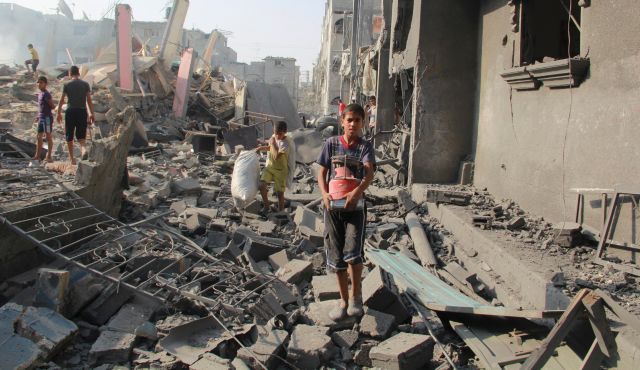
After more than 24 hours of Israeli aerial bombardments, at an average of five an hour, and heavy artillery fire on Rafah, the city's medical facilities have had to place the bodies of the dead in cold storage designed for fruits and vegetables. This step had to be taken not only because of the high number of casualties, but because Rafah's Yusuf al-Najar Hospital had to be evacuated after bombardments and artillery fire that endangered the lives of patients and staff. Because cemeteries and funeral processions are also being bombarded, people are afraid to bury their dead.
After the collapse of the cease-fire Friday, about two hours after it began, Rafah residents said the Israel Defense Forces bombarded and fired on houses indiscriminately, with the inhabitants still inside. They reported that when they tried to flee they were bombarded in the street. "All the houses shook like in an earthquake, "residents told Haaretz.
A few thousand people living in neighborhoods on the edge of Rafah fled to the Shabura refugee camp, considered "protected" from ground invasion. But at 3 A.M. Saturday a bomb dropped by an Israeli fighter jet on a number of asbestos dwellings in the camp killed eight people from three families, including three girls and three boys, a woman and a man of about 50. Fighter jets and gun boats also bombarded civilian neighborhoods in the west of the city, killing at least 20 civilians, most of them mainly children.
Between 10 A.M. Friday and 10 A.M. Saturday about 100 air strikes and a few hundred artillery strikes were counted. In Rafah alone 123 civilians were killed, including 30 children and 14 women, according to the Palestinian Center for Human Rights. Altogether throughout the Gaza Strip in that 24-hour period, 143 Palestinians were killed - including 39 children and 16 women, according to the center.
Palestinian Health Ministry figures on Saturday afternoon put the number of Palestinians killed throughout the Gaza Strip Friday and Saturday at 256, and 813 wounded. Since the operation began, some 1,680 Palestinians have been killed and more than 9,000 have been injured.
At around 3:30 P.M. Friday at around an Israeli fighter jet bombed a Palestinian Health Ministry ambulance, killing the driver, Atef Salah a-Zamali, 42, a nurse and relative of the driver, Yusuf, 33, and a volunteer on the rescue team, Yusuf Darabiyyeh, 25.
Because of the bombardments the seriously injured could not be taken to the European hospital in northeastern Rafah. Under unceasing bombardment, the injured were taken to small private hospitals and clinics in the city.
A single Israeli bombardment on Friday of the house of Rafat Za'arub, in the Saudi neighborhood in western Rafah, killed 13 inhabitants, including seven children and three women. A direct hit on the home of Fathi Abu Sleiman in the western Rafah neighborhood of Tel al-Sultan killed seven people: the mother of the family, five of her children and another woman.
A senior member of the Hamas political wing told Haaretz on Saturday that Israel had violated the cease-fire. "Benjamin Netanyahu's insistence on destroying tunnels in our territory, which are a clear defensive tool, is a violation of the agreement. All the work in the tunnel involves the destruction of civilian houses - which contradicts the essence of the time-out."
As opposed to Israel's claim that Hamas violated the cease-fire by kidnapping 2nd Lt. Hadar Goldin, Hamas spokesmen continued to maintain that they have no knowledge of Goldin's whereabouts and that the IDF began to bombard Rafah at 9:30 A.M. on Friday when they discovered a soldier missing.
According to residents, a few hours before the cease-fire IDF forces advanced westward in the Rafah area through the village of Shukha up to 1.5 kilometers from the border. The residents had had to leave their homes over the past two or three weeks because the IDF had turned it into a buffer zone by bombardment and ground raids. Then the soldiers left, the residents said. But when they returned Friday morning to get food and clothing, they found infantry troops deployed there who began firing on civilians in their homes at around 9:40 A.M.
Between 8 A.M. and 10 A.M. some residents of the Strip began to feel the cease-fire. Many went to the beach and fishermen from the Shati refugee camp north of Gaza went fishing and had time to take the fish to market. But when the bombardments began again, they were seen collecting their fish and driving quickly home. Palestinian teams also managed to pull bodies from the wreckage of homes. In the village of Khuza'a, east of Khan Yunis, 51 bodies were pulled from the rubble, 22 civilians and the rest Hamas fighters.



Reader Comments
to our Newsletter